IBS Report: Analyzing Marketing, Finance, and HR at Greggs plc
VerifiedAdded on 2023/01/11
|9
|2040
|62
Report
AI Summary
This report provides an in-depth analysis of Greggs plc, a leading UK bakery chain, focusing on the key roles and importance of its marketing, finance, and HR departments. It defines each department, outlining their specific functions and contributions to the company's overall performance. The report explores how these departments are interconnected and the impact of their collaboration on Greggs' operational effectiveness and strategic goals. The marketing section covers brand management, campaign execution, promotional materials, social media management, and media relations. The finance section focuses on cash flow management, budgeting, long-term financing, and financial reporting. The HR section addresses strategic management, safety, compensation, training, and benefits analysis. The report emphasizes the importance of cross-functional collaboration for organizational success and concludes by reiterating the value of integrating these key business functions to achieve targets and sustain growth.

IBS Report Greggs
Paraphrase This Document
Need a fresh take? Get an instant paraphrase of this document with our AI Paraphraser
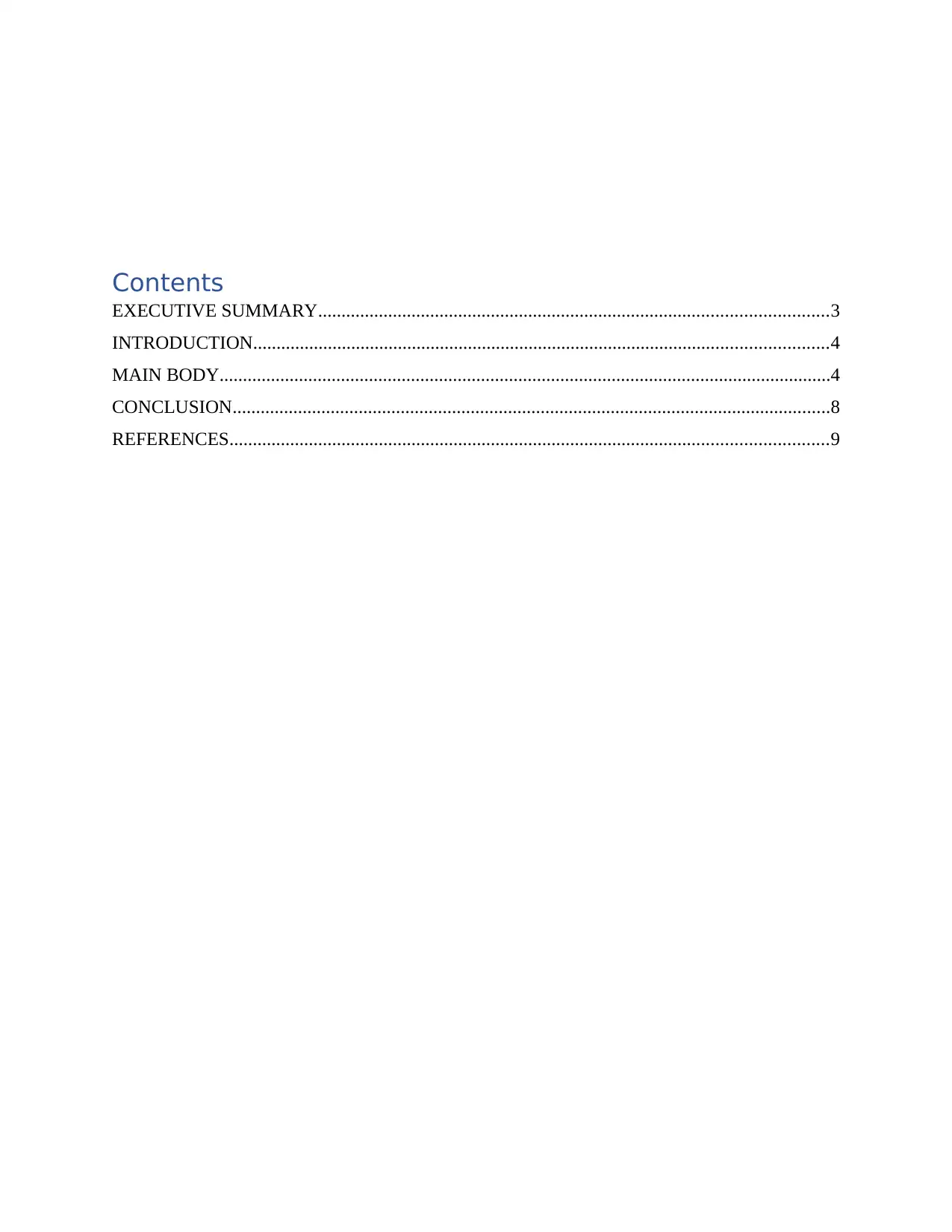
Contents
EXECUTIVE SUMMARY.............................................................................................................3
INTRODUCTION...........................................................................................................................4
MAIN BODY...................................................................................................................................4
CONCLUSION................................................................................................................................8
REFERENCES................................................................................................................................9
EXECUTIVE SUMMARY.............................................................................................................3
INTRODUCTION...........................................................................................................................4
MAIN BODY...................................................................................................................................4
CONCLUSION................................................................................................................................8
REFERENCES................................................................................................................................9
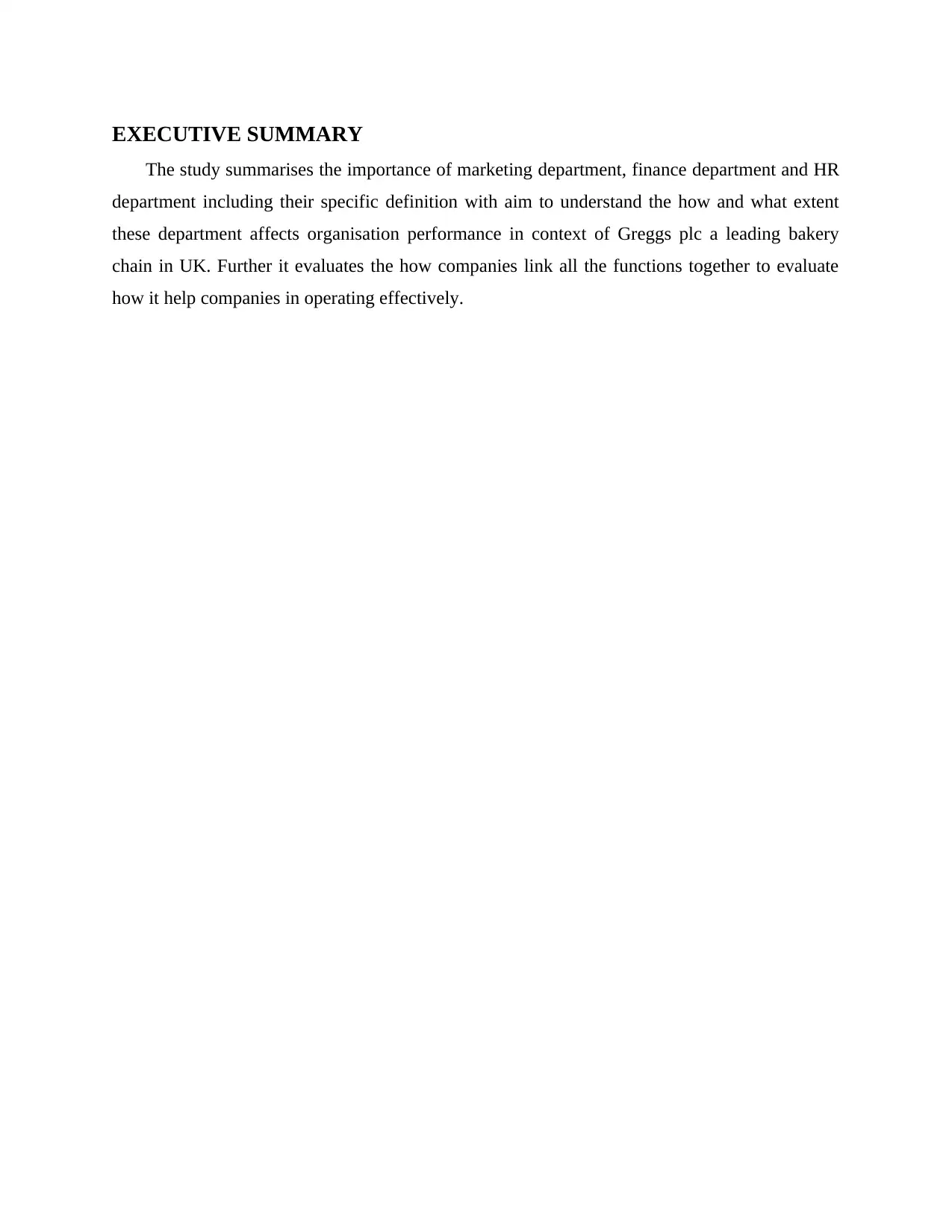
EXECUTIVE SUMMARY
The study summarises the importance of marketing department, finance department and HR
department including their specific definition with aim to understand the how and what extent
these department affects organisation performance in context of Greggs plc a leading bakery
chain in UK. Further it evaluates the how companies link all the functions together to evaluate
how it help companies in operating effectively.
The study summarises the importance of marketing department, finance department and HR
department including their specific definition with aim to understand the how and what extent
these department affects organisation performance in context of Greggs plc a leading bakery
chain in UK. Further it evaluates the how companies link all the functions together to evaluate
how it help companies in operating effectively.
⊘ This is a preview!⊘
Do you want full access?
Subscribe today to unlock all pages.

Trusted by 1+ million students worldwide
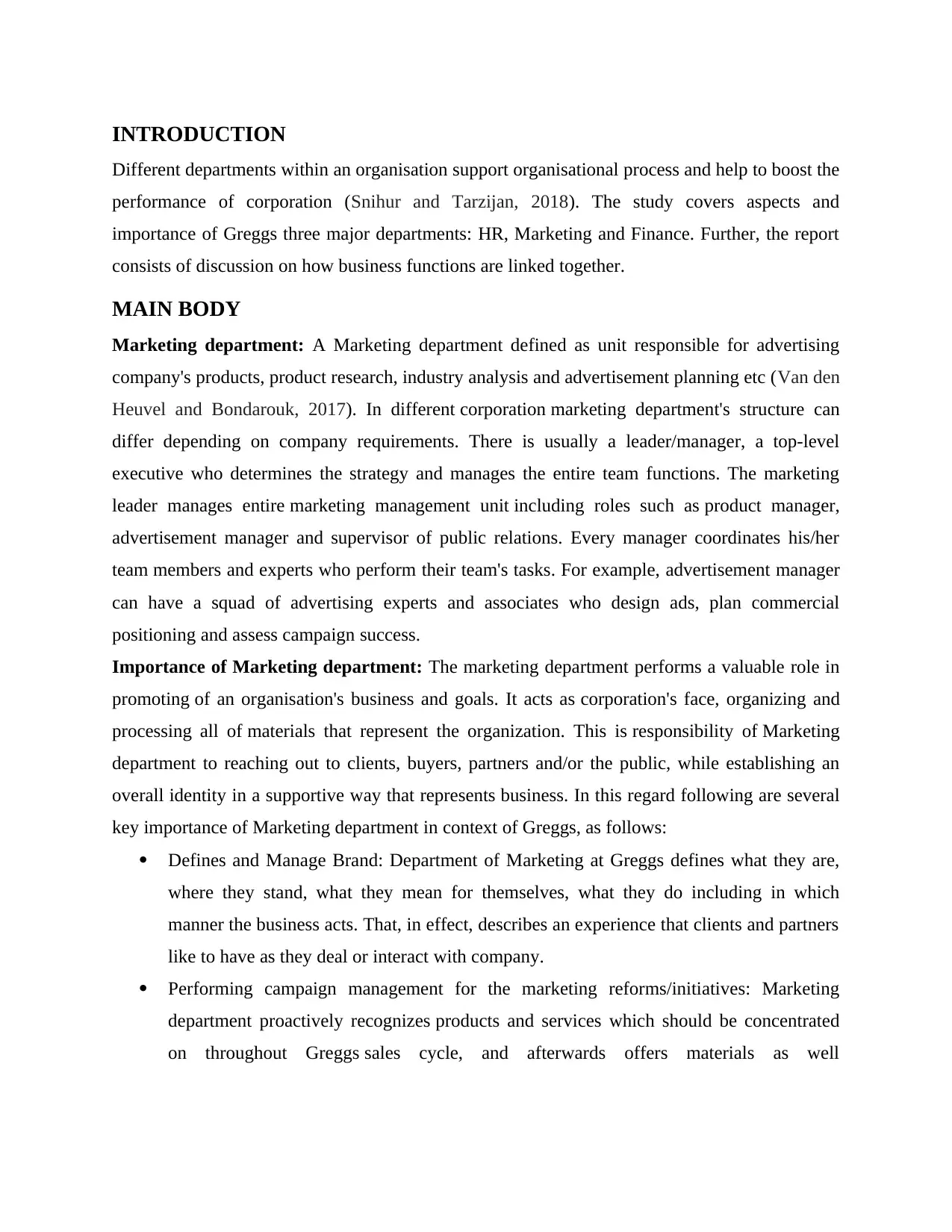
INTRODUCTION
Different departments within an organisation support organisational process and help to boost the
performance of corporation (Snihur and Tarzijan, 2018). The study covers aspects and
importance of Greggs three major departments: HR, Marketing and Finance. Further, the report
consists of discussion on how business functions are linked together.
MAIN BODY
Marketing department: A Marketing department defined as unit responsible for advertising
company's products, product research, industry analysis and advertisement planning etc (Van den
Heuvel and Bondarouk, 2017). In different corporation marketing department's structure can
differ depending on company requirements. There is usually a leader/manager, a top-level
executive who determines the strategy and manages the entire team functions. The marketing
leader manages entire marketing management unit including roles such as product manager,
advertisement manager and supervisor of public relations. Every manager coordinates his/her
team members and experts who perform their team's tasks. For example, advertisement manager
can have a squad of advertising experts and associates who design ads, plan commercial
positioning and assess campaign success.
Importance of Marketing department: The marketing department performs a valuable role in
promoting of an organisation's business and goals. It acts as corporation's face, organizing and
processing all of materials that represent the organization. This is responsibility of Marketing
department to reaching out to clients, buyers, partners and/or the public, while establishing an
overall identity in a supportive way that represents business. In this regard following are several
key importance of Marketing department in context of Greggs, as follows:
Defines and Manage Brand: Department of Marketing at Greggs defines what they are,
where they stand, what they mean for themselves, what they do including in which
manner the business acts. That, in effect, describes an experience that clients and partners
like to have as they deal or interact with company.
Performing campaign management for the marketing reforms/initiatives: Marketing
department proactively recognizes products and services which should be concentrated
on throughout Greggs sales cycle, and afterwards offers materials as well
Different departments within an organisation support organisational process and help to boost the
performance of corporation (Snihur and Tarzijan, 2018). The study covers aspects and
importance of Greggs three major departments: HR, Marketing and Finance. Further, the report
consists of discussion on how business functions are linked together.
MAIN BODY
Marketing department: A Marketing department defined as unit responsible for advertising
company's products, product research, industry analysis and advertisement planning etc (Van den
Heuvel and Bondarouk, 2017). In different corporation marketing department's structure can
differ depending on company requirements. There is usually a leader/manager, a top-level
executive who determines the strategy and manages the entire team functions. The marketing
leader manages entire marketing management unit including roles such as product manager,
advertisement manager and supervisor of public relations. Every manager coordinates his/her
team members and experts who perform their team's tasks. For example, advertisement manager
can have a squad of advertising experts and associates who design ads, plan commercial
positioning and assess campaign success.
Importance of Marketing department: The marketing department performs a valuable role in
promoting of an organisation's business and goals. It acts as corporation's face, organizing and
processing all of materials that represent the organization. This is responsibility of Marketing
department to reaching out to clients, buyers, partners and/or the public, while establishing an
overall identity in a supportive way that represents business. In this regard following are several
key importance of Marketing department in context of Greggs, as follows:
Defines and Manage Brand: Department of Marketing at Greggs defines what they are,
where they stand, what they mean for themselves, what they do including in which
manner the business acts. That, in effect, describes an experience that clients and partners
like to have as they deal or interact with company.
Performing campaign management for the marketing reforms/initiatives: Marketing
department proactively recognizes products and services which should be concentrated
on throughout Greggs sales cycle, and afterwards offers materials as well
Paraphrase This Document
Need a fresh take? Get an instant paraphrase of this document with our AI Paraphraser
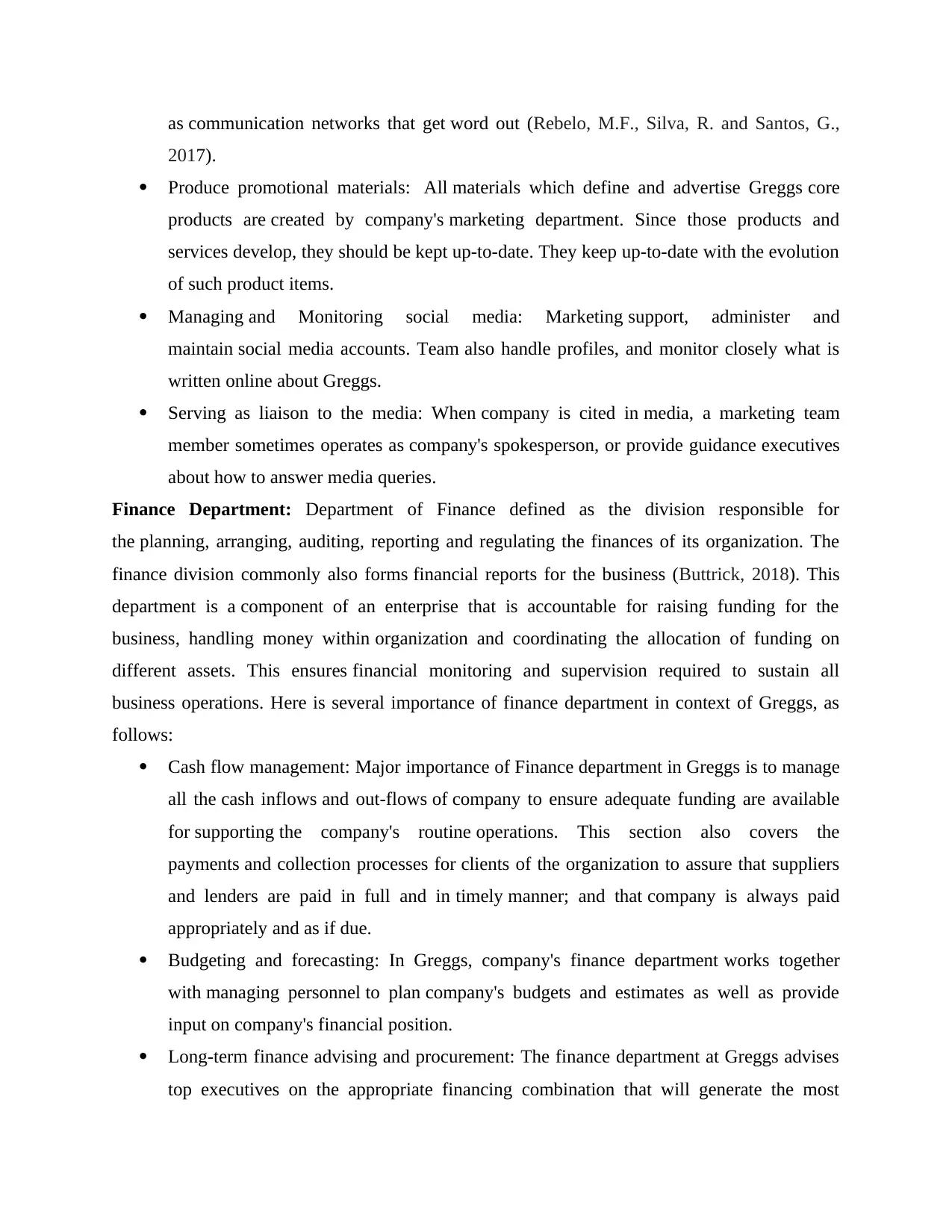
as communication networks that get word out (Rebelo, M.F., Silva, R. and Santos, G.,
2017).
Produce promotional materials: All materials which define and advertise Greggs core
products are created by company's marketing department. Since those products and
services develop, they should be kept up-to-date. They keep up-to-date with the evolution
of such product items.
Managing and Monitoring social media: Marketing support, administer and
maintain social media accounts. Team also handle profiles, and monitor closely what is
written online about Greggs.
Serving as liaison to the media: When company is cited in media, a marketing team
member sometimes operates as company's spokesperson, or provide guidance executives
about how to answer media queries.
Finance Department: Department of Finance defined as the division responsible for
the planning, arranging, auditing, reporting and regulating the finances of its organization. The
finance division commonly also forms financial reports for the business (Buttrick, 2018). This
department is a component of an enterprise that is accountable for raising funding for the
business, handling money within organization and coordinating the allocation of funding on
different assets. This ensures financial monitoring and supervision required to sustain all
business operations. Here is several importance of finance department in context of Greggs, as
follows:
Cash flow management: Major importance of Finance department in Greggs is to manage
all the cash inflows and out-flows of company to ensure adequate funding are available
for supporting the company's routine operations. This section also covers the
payments and collection processes for clients of the organization to assure that suppliers
and lenders are paid in full and in timely manner; and that company is always paid
appropriately and as if due.
Budgeting and forecasting: In Greggs, company's finance department works together
with managing personnel to plan company's budgets and estimates as well as provide
input on company's financial position.
Long-term finance advising and procurement: The finance department at Greggs advises
top executives on the appropriate financing combination that will generate the most
2017).
Produce promotional materials: All materials which define and advertise Greggs core
products are created by company's marketing department. Since those products and
services develop, they should be kept up-to-date. They keep up-to-date with the evolution
of such product items.
Managing and Monitoring social media: Marketing support, administer and
maintain social media accounts. Team also handle profiles, and monitor closely what is
written online about Greggs.
Serving as liaison to the media: When company is cited in media, a marketing team
member sometimes operates as company's spokesperson, or provide guidance executives
about how to answer media queries.
Finance Department: Department of Finance defined as the division responsible for
the planning, arranging, auditing, reporting and regulating the finances of its organization. The
finance division commonly also forms financial reports for the business (Buttrick, 2018). This
department is a component of an enterprise that is accountable for raising funding for the
business, handling money within organization and coordinating the allocation of funding on
different assets. This ensures financial monitoring and supervision required to sustain all
business operations. Here is several importance of finance department in context of Greggs, as
follows:
Cash flow management: Major importance of Finance department in Greggs is to manage
all the cash inflows and out-flows of company to ensure adequate funding are available
for supporting the company's routine operations. This section also covers the
payments and collection processes for clients of the organization to assure that suppliers
and lenders are paid in full and in timely manner; and that company is always paid
appropriately and as if due.
Budgeting and forecasting: In Greggs, company's finance department works together
with managing personnel to plan company's budgets and estimates as well as provide
input on company's financial position.
Long-term finance advising and procurement: The finance department at Greggs advises
top executives on the appropriate financing combination that will generate the most
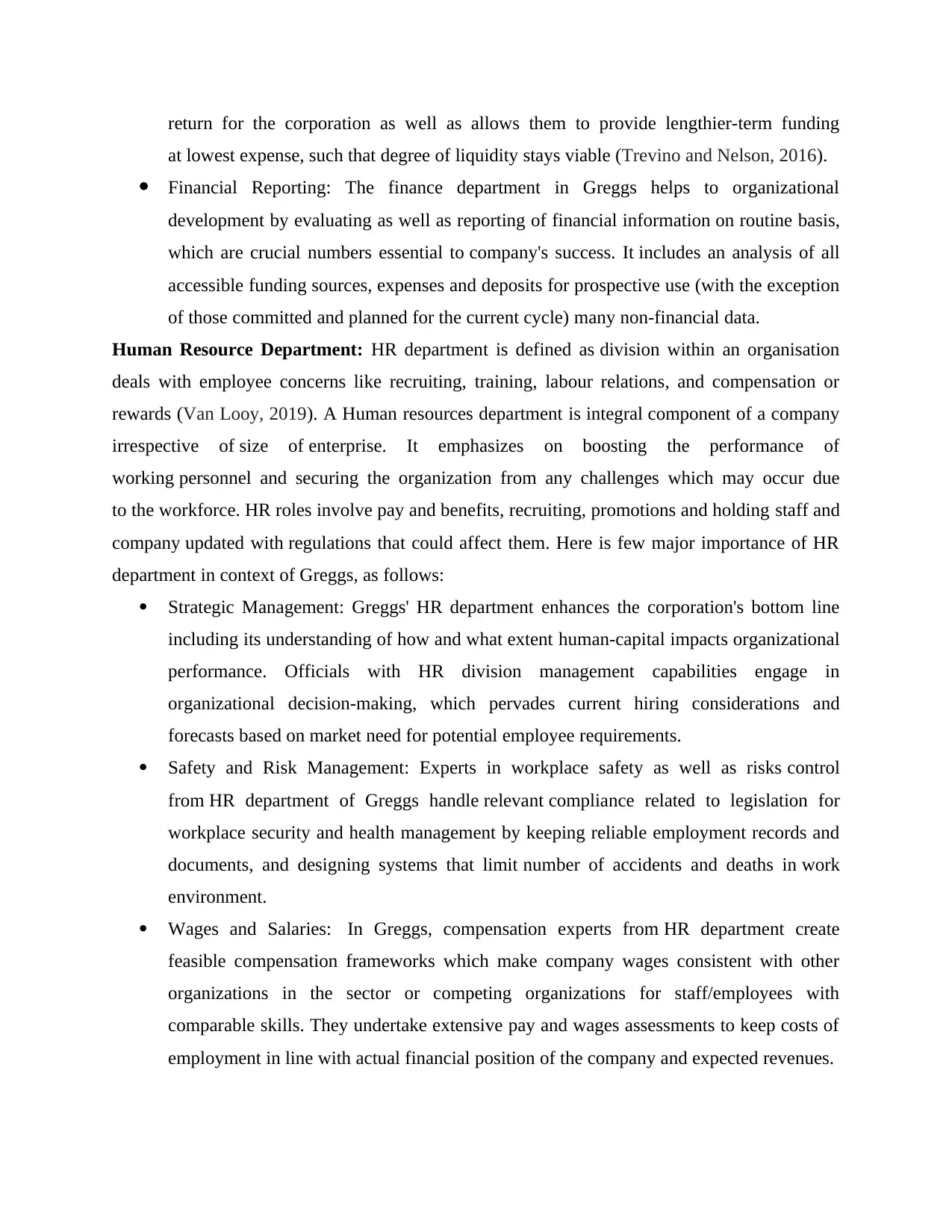
return for the corporation as well as allows them to provide lengthier-term funding
at lowest expense, such that degree of liquidity stays viable (Trevino and Nelson, 2016).
Financial Reporting: The finance department in Greggs helps to organizational
development by evaluating as well as reporting of financial information on routine basis,
which are crucial numbers essential to company's success. It includes an analysis of all
accessible funding sources, expenses and deposits for prospective use (with the exception
of those committed and planned for the current cycle) many non-financial data.
Human Resource Department: HR department is defined as division within an organisation
deals with employee concerns like recruiting, training, labour relations, and compensation or
rewards (Van Looy, 2019). A Human resources department is integral component of a company
irrespective of size of enterprise. It emphasizes on boosting the performance of
working personnel and securing the organization from any challenges which may occur due
to the workforce. HR roles involve pay and benefits, recruiting, promotions and holding staff and
company updated with regulations that could affect them. Here is few major importance of HR
department in context of Greggs, as follows:
Strategic Management: Greggs' HR department enhances the corporation's bottom line
including its understanding of how and what extent human-capital impacts organizational
performance. Officials with HR division management capabilities engage in
organizational decision-making, which pervades current hiring considerations and
forecasts based on market need for potential employee requirements.
Safety and Risk Management: Experts in workplace safety as well as risks control
from HR department of Greggs handle relevant compliance related to legislation for
workplace security and health management by keeping reliable employment records and
documents, and designing systems that limit number of accidents and deaths in work
environment.
Wages and Salaries: In Greggs, compensation experts from HR department create
feasible compensation frameworks which make company wages consistent with other
organizations in the sector or competing organizations for staff/employees with
comparable skills. They undertake extensive pay and wages assessments to keep costs of
employment in line with actual financial position of the company and expected revenues.
at lowest expense, such that degree of liquidity stays viable (Trevino and Nelson, 2016).
Financial Reporting: The finance department in Greggs helps to organizational
development by evaluating as well as reporting of financial information on routine basis,
which are crucial numbers essential to company's success. It includes an analysis of all
accessible funding sources, expenses and deposits for prospective use (with the exception
of those committed and planned for the current cycle) many non-financial data.
Human Resource Department: HR department is defined as division within an organisation
deals with employee concerns like recruiting, training, labour relations, and compensation or
rewards (Van Looy, 2019). A Human resources department is integral component of a company
irrespective of size of enterprise. It emphasizes on boosting the performance of
working personnel and securing the organization from any challenges which may occur due
to the workforce. HR roles involve pay and benefits, recruiting, promotions and holding staff and
company updated with regulations that could affect them. Here is few major importance of HR
department in context of Greggs, as follows:
Strategic Management: Greggs' HR department enhances the corporation's bottom line
including its understanding of how and what extent human-capital impacts organizational
performance. Officials with HR division management capabilities engage in
organizational decision-making, which pervades current hiring considerations and
forecasts based on market need for potential employee requirements.
Safety and Risk Management: Experts in workplace safety as well as risks control
from HR department of Greggs handle relevant compliance related to legislation for
workplace security and health management by keeping reliable employment records and
documents, and designing systems that limit number of accidents and deaths in work
environment.
Wages and Salaries: In Greggs, compensation experts from HR department create
feasible compensation frameworks which make company wages consistent with other
organizations in the sector or competing organizations for staff/employees with
comparable skills. They undertake extensive pay and wages assessments to keep costs of
employment in line with actual financial position of the company and expected revenues.
⊘ This is a preview!⊘
Do you want full access?
Subscribe today to unlock all pages.

Trusted by 1+ million students worldwide
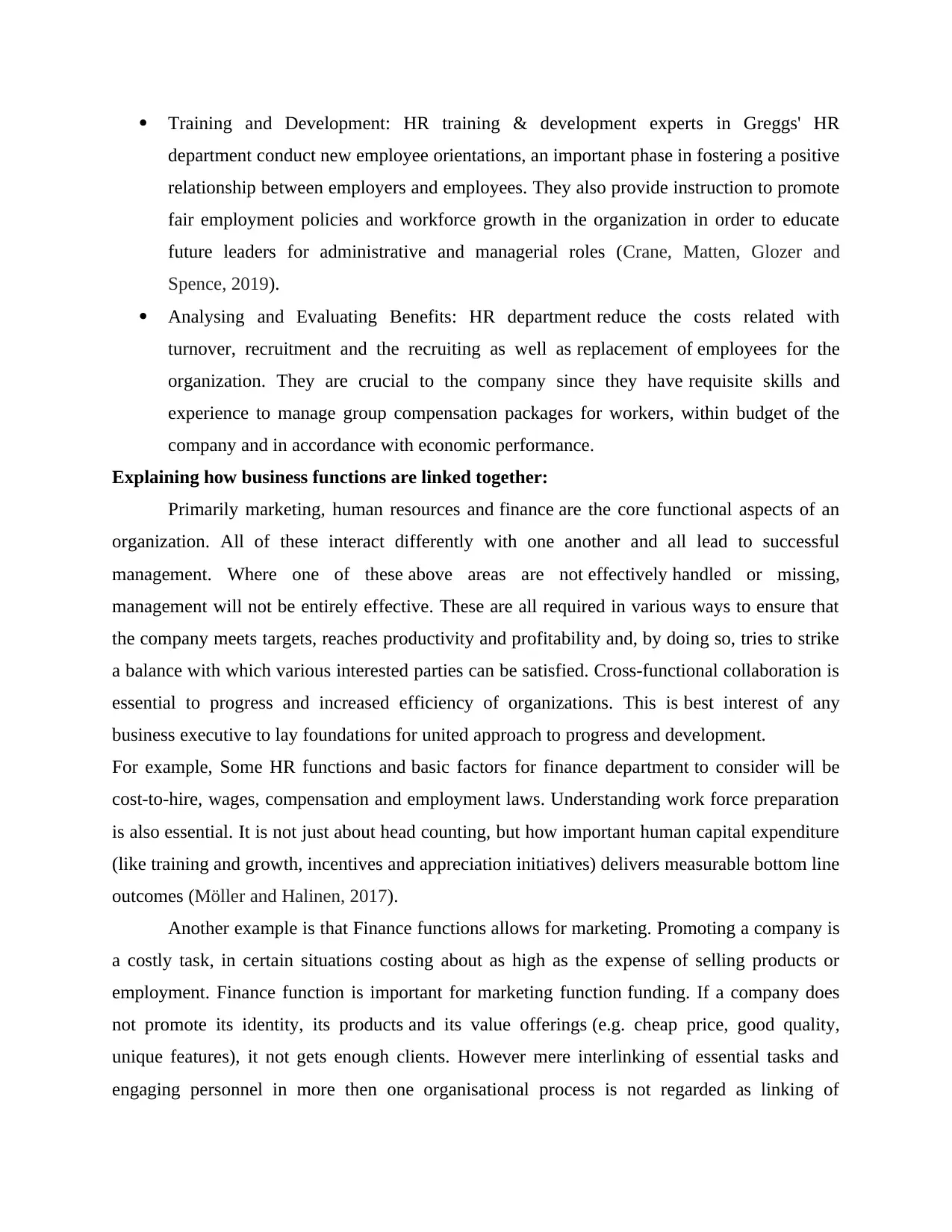
Training and Development: HR training & development experts in Greggs' HR
department conduct new employee orientations, an important phase in fostering a positive
relationship between employers and employees. They also provide instruction to promote
fair employment policies and workforce growth in the organization in order to educate
future leaders for administrative and managerial roles (Crane, Matten, Glozer and
Spence, 2019).
Analysing and Evaluating Benefits: HR department reduce the costs related with
turnover, recruitment and the recruiting as well as replacement of employees for the
organization. They are crucial to the company since they have requisite skills and
experience to manage group compensation packages for workers, within budget of the
company and in accordance with economic performance.
Explaining how business functions are linked together:
Primarily marketing, human resources and finance are the core functional aspects of an
organization. All of these interact differently with one another and all lead to successful
management. Where one of these above areas are not effectively handled or missing,
management will not be entirely effective. These are all required in various ways to ensure that
the company meets targets, reaches productivity and profitability and, by doing so, tries to strike
a balance with which various interested parties can be satisfied. Cross-functional collaboration is
essential to progress and increased efficiency of organizations. This is best interest of any
business executive to lay foundations for united approach to progress and development.
For example, Some HR functions and basic factors for finance department to consider will be
cost-to-hire, wages, compensation and employment laws. Understanding work force preparation
is also essential. It is not just about head counting, but how important human capital expenditure
(like training and growth, incentives and appreciation initiatives) delivers measurable bottom line
outcomes (Möller and Halinen, 2017).
Another example is that Finance functions allows for marketing. Promoting a company is
a costly task, in certain situations costing about as high as the expense of selling products or
employment. Finance function is important for marketing function funding. If a company does
not promote its identity, its products and its value offerings (e.g. cheap price, good quality,
unique features), it not gets enough clients. However mere interlinking of essential tasks and
engaging personnel in more then one organisational process is not regarded as linking of
department conduct new employee orientations, an important phase in fostering a positive
relationship between employers and employees. They also provide instruction to promote
fair employment policies and workforce growth in the organization in order to educate
future leaders for administrative and managerial roles (Crane, Matten, Glozer and
Spence, 2019).
Analysing and Evaluating Benefits: HR department reduce the costs related with
turnover, recruitment and the recruiting as well as replacement of employees for the
organization. They are crucial to the company since they have requisite skills and
experience to manage group compensation packages for workers, within budget of the
company and in accordance with economic performance.
Explaining how business functions are linked together:
Primarily marketing, human resources and finance are the core functional aspects of an
organization. All of these interact differently with one another and all lead to successful
management. Where one of these above areas are not effectively handled or missing,
management will not be entirely effective. These are all required in various ways to ensure that
the company meets targets, reaches productivity and profitability and, by doing so, tries to strike
a balance with which various interested parties can be satisfied. Cross-functional collaboration is
essential to progress and increased efficiency of organizations. This is best interest of any
business executive to lay foundations for united approach to progress and development.
For example, Some HR functions and basic factors for finance department to consider will be
cost-to-hire, wages, compensation and employment laws. Understanding work force preparation
is also essential. It is not just about head counting, but how important human capital expenditure
(like training and growth, incentives and appreciation initiatives) delivers measurable bottom line
outcomes (Möller and Halinen, 2017).
Another example is that Finance functions allows for marketing. Promoting a company is
a costly task, in certain situations costing about as high as the expense of selling products or
employment. Finance function is important for marketing function funding. If a company does
not promote its identity, its products and its value offerings (e.g. cheap price, good quality,
unique features), it not gets enough clients. However mere interlinking of essential tasks and
engaging personnel in more then one organisational process is not regarded as linking of
Paraphrase This Document
Need a fresh take? Get an instant paraphrase of this document with our AI Paraphraser
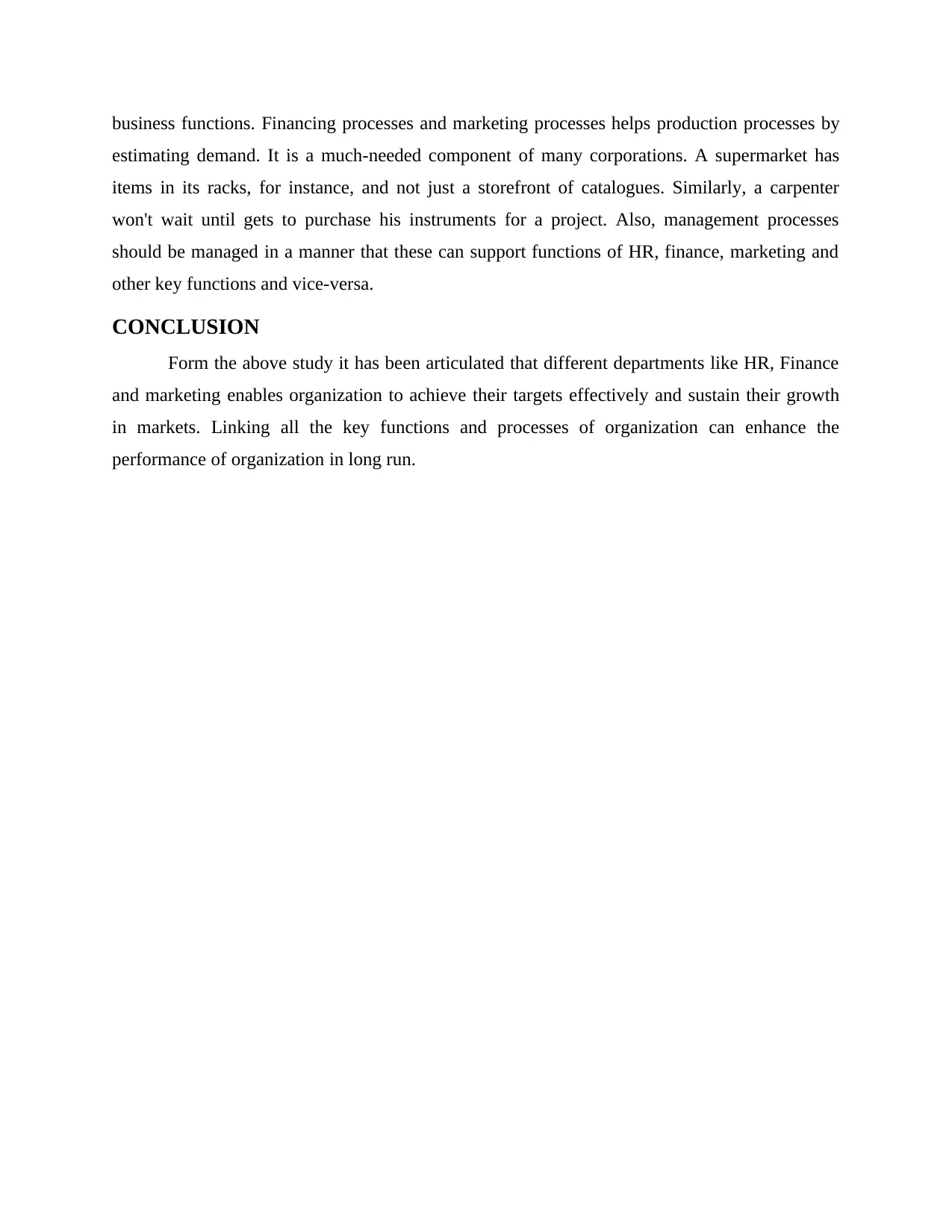
business functions. Financing processes and marketing processes helps production processes by
estimating demand. It is a much-needed component of many corporations. A supermarket has
items in its racks, for instance, and not just a storefront of catalogues. Similarly, a carpenter
won't wait until gets to purchase his instruments for a project. Also, management processes
should be managed in a manner that these can support functions of HR, finance, marketing and
other key functions and vice-versa.
CONCLUSION
Form the above study it has been articulated that different departments like HR, Finance
and marketing enables organization to achieve their targets effectively and sustain their growth
in markets. Linking all the key functions and processes of organization can enhance the
performance of organization in long run.
estimating demand. It is a much-needed component of many corporations. A supermarket has
items in its racks, for instance, and not just a storefront of catalogues. Similarly, a carpenter
won't wait until gets to purchase his instruments for a project. Also, management processes
should be managed in a manner that these can support functions of HR, finance, marketing and
other key functions and vice-versa.
CONCLUSION
Form the above study it has been articulated that different departments like HR, Finance
and marketing enables organization to achieve their targets effectively and sustain their growth
in markets. Linking all the key functions and processes of organization can enhance the
performance of organization in long run.
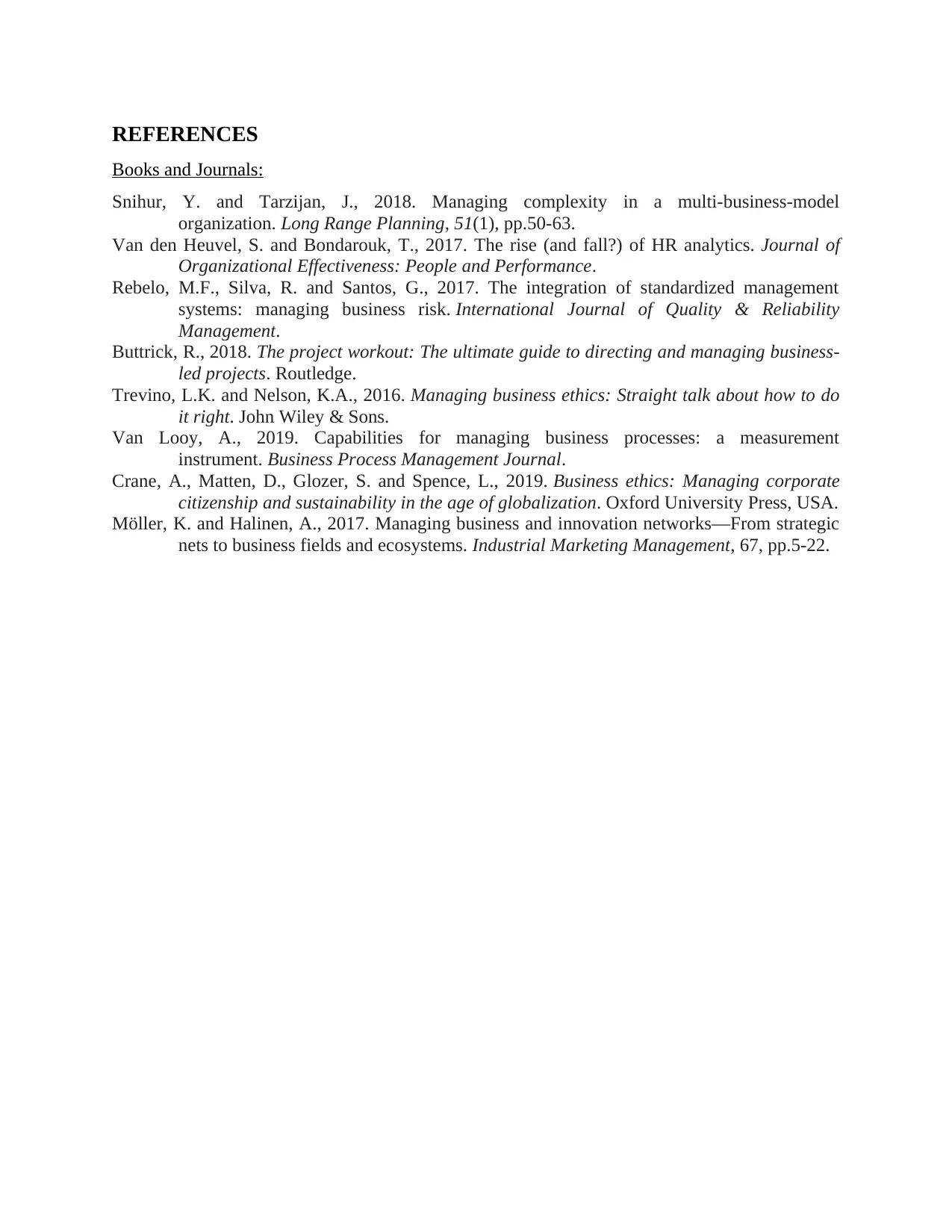
REFERENCES
Books and Journals:
Snihur, Y. and Tarzijan, J., 2018. Managing complexity in a multi-business-model
organization. Long Range Planning, 51(1), pp.50-63.
Van den Heuvel, S. and Bondarouk, T., 2017. The rise (and fall?) of HR analytics. Journal of
Organizational Effectiveness: People and Performance.
Rebelo, M.F., Silva, R. and Santos, G., 2017. The integration of standardized management
systems: managing business risk. International Journal of Quality & Reliability
Management.
Buttrick, R., 2018. The project workout: The ultimate guide to directing and managing business-
led projects. Routledge.
Trevino, L.K. and Nelson, K.A., 2016. Managing business ethics: Straight talk about how to do
it right. John Wiley & Sons.
Van Looy, A., 2019. Capabilities for managing business processes: a measurement
instrument. Business Process Management Journal.
Crane, A., Matten, D., Glozer, S. and Spence, L., 2019. Business ethics: Managing corporate
citizenship and sustainability in the age of globalization. Oxford University Press, USA.
Möller, K. and Halinen, A., 2017. Managing business and innovation networks—From strategic
nets to business fields and ecosystems. Industrial Marketing Management, 67, pp.5-22.
Books and Journals:
Snihur, Y. and Tarzijan, J., 2018. Managing complexity in a multi-business-model
organization. Long Range Planning, 51(1), pp.50-63.
Van den Heuvel, S. and Bondarouk, T., 2017. The rise (and fall?) of HR analytics. Journal of
Organizational Effectiveness: People and Performance.
Rebelo, M.F., Silva, R. and Santos, G., 2017. The integration of standardized management
systems: managing business risk. International Journal of Quality & Reliability
Management.
Buttrick, R., 2018. The project workout: The ultimate guide to directing and managing business-
led projects. Routledge.
Trevino, L.K. and Nelson, K.A., 2016. Managing business ethics: Straight talk about how to do
it right. John Wiley & Sons.
Van Looy, A., 2019. Capabilities for managing business processes: a measurement
instrument. Business Process Management Journal.
Crane, A., Matten, D., Glozer, S. and Spence, L., 2019. Business ethics: Managing corporate
citizenship and sustainability in the age of globalization. Oxford University Press, USA.
Möller, K. and Halinen, A., 2017. Managing business and innovation networks—From strategic
nets to business fields and ecosystems. Industrial Marketing Management, 67, pp.5-22.
⊘ This is a preview!⊘
Do you want full access?
Subscribe today to unlock all pages.

Trusted by 1+ million students worldwide
1 out of 9
Related Documents
Your All-in-One AI-Powered Toolkit for Academic Success.
+13062052269
info@desklib.com
Available 24*7 on WhatsApp / Email
![[object Object]](/_next/static/media/star-bottom.7253800d.svg)
Unlock your academic potential
Copyright © 2020–2025 A2Z Services. All Rights Reserved. Developed and managed by ZUCOL.




